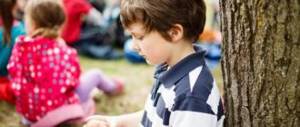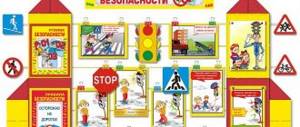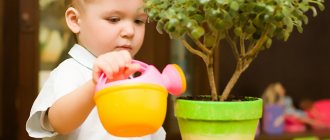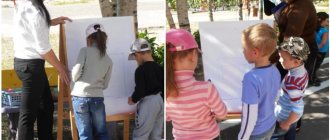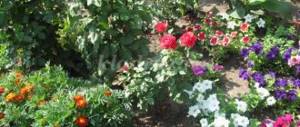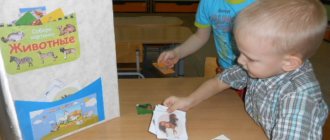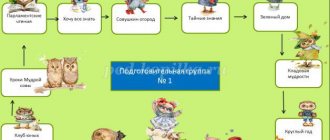The role of riddles in the development of a preschooler
Page 1 of 2
Introduction
The introduction of new technologies in teaching preschoolers is dictated by a change in the modern pedagogical situation, characterized by the humanization of the pedagogical process, an appeal to the child’s personality, a departure from information-prescription teaching based on repetition, imitation and listening, during which the child largely loses his innate research behavior , the ability to think independently, to independently understand the world around us is lost. Even J. Piaget constantly emphasized that often, by teaching children specific skills, we deprive them of the chance to make their own discovery.
The main task facing modern teachers is to educate a creative personality, and creativity does not come just like that, creativity must be learned. V.A. Sukhomlinsky urged not to miss that happy period: “...to reach in every person the vein from which unique talent begins.” And here, as one of the effective means of developing a child’s mental activity and speech, a riddle appears.
The importance of riddles in working with preschool children
The methodological foundations of the theory of speech development in preschool children and general theoretical issues were dealt with by such scientists as: K.D. Ushinsky, E.I. Tikheyeva, A.P. Usova, M.M. Alekseeva, D.B. Elkonin, A.N. Gvozdeva, L.S. Vygotsky and others. In their works, they raised the problem of developing a preschooler’s cognitive interest in acquiring new knowledge, looking for ways not to simply transfer ready-made knowledge to the child, but to create situations, methods and techniques that would help the child independently obtain knowledge, discover new things in already acquaintances and enjoy their research activities.
One of the means for the comprehensive development of a child can be called ordinary riddles. They become such when they are presented to children not just as fun, but as a fun, but quite serious activity. K.D. Ushinsky wrote that a riddle provides a useful exercise for the child’s mind, and for the teacher it gives the opportunity to make the lesson entertaining, interesting, and what could be more interesting than finding the answer yourself or coming up with a new one, your own?
Riddles teach children the ability to observe, noticing something special, the ability to see the essence of an object, its purpose. A riddle always contains a question that requires mental activity, concentration, imagination, and of course gives the child new knowledge about the world around him. This is knowledge about new objects, about nature and its phenomena, about animals and their habits, about relationships between people. Riddles in a concentrated, symbolic form, accessible to children, reflect children's experience of understanding reality.
The riddle is of particular importance for the development of the speech of a preschooler. Acquisition of the native language, which occurs intensively in preschool age, consists in the assimilation of its entire morphological system, associated with the child’s extreme activity in relation to language, expressed, in particular, in diverse word formations and word changes made by the child by analogy with already acquired forms. K.I. Chukovsky emphasized that it is precisely the period from two to five years that a child has an extraordinary sense of language, which leads to its active assimilation.
Guessing and inventing riddles has an impact on the diversified development of children's speech. The use of a metaphorical image to create a riddle, the use of various means of expressiveness (personification, various definitions, epithets, comparisons, special rhythmic organization) contribute to the formation of figurative speech in preschool children. Riddles enrich children's vocabulary due to the polysemy of words, help them see the secondary meanings of words, and form ideas about the figurative meaning of a word. They help to master the sound and grammatical structure of Russian speech, forcing you to focus on the linguistic form and analyze it.
A riddle, stimulating a child’s mental activity, always puts him on the path to solving a certain problem. Solving riddles develops the ability to analyze, generalize, and forms the ability to independently draw conclusions and conclusions. A riddle teaches you to clearly identify the most characteristic, expressive features of an object or phenomenon, clearly and concisely convey images of objects, and develops in children a poetic view of reality.
SOUTH. Illarionova believes that the use of riddles in working with children contributes to their development of evidentiary and descriptive speech skills. To be able to prove is not only to be able to think correctly, logically, but also to correctly express one’s thought, putting it in precise verbal form. Speech - proof requires special speech patterns, grammatical structures, and special composition that are different from description and narration.
To arouse children's interest and need for proof, Yu.G. Illarionova recommends setting a specific goal for your child when solving riddles: not just to guess the riddle, but to prove that the answer is correct. It is necessary to teach children to perceive objects and phenomena of the world around them in the fullness and depth of connections and relationships. Introduce in advance the objects and phenomena about which riddles will be offered. Then the evidence will be more reasonable and complete.
Systematic work on developing children's evidentiary speech skills when explaining riddles develops the ability to use varied and interesting arguments to better justify the answer. In order for children to quickly master the descriptive form of speech, it is necessary to draw their attention to the linguistic features of the riddle, teach them to notice the beauty and originality of an artistic image, understand what speech means it is created by, and develop a taste for precise and figurative words. Taking into account the material of the riddle, it is necessary to teach children to see the compositional features of the riddle, to feel the originality of its rhythms and syntactic structures.
For these purposes, the language of the riddle is analyzed and attention is paid to its construction. It is recommended to have several riddles about one object or phenomenon in stock in order to show children that the images and expressions they found are not isolated, that there are many opportunities to say differently and very succinctly and colorfully about the same thing. Mastering the skills of descriptive speech is more successful if, along with riddles, literary works, illustrations, and paintings are taken as examples.
Riddle - a small genre of folklore
A child’s acquaintance with works of fiction begins with miniatures of folk art - nursery rhymes, songs, riddles, fairy tales, etc. Indispensable humor, figurative language, moral orientation are the features of these folklore miniature works. The people are unsurpassed teachers of speech. In no other works, except folk ones, can one find such an ideal combination of difficult-to-pronounce sounds, such a well-thought-out arrangement of words in terms of sound. And friendly folk humor is the best remedy against laziness, cowardice, stubbornness, whims, and selfishness.
The development of speech of preschool children in small folklore genres was carried out by such scientists as: Yu.G. Illarionova, E.I. Tikheyeva, F.A. Sohima, A.M. Borodich, A.P. Usova, A.Ya. Matskevich and others. In their works they did not ignore the riddle, as one of the oldest genres of folk art, which a child encounters in early childhood. Famous folklorist V.I. Chicherova gave the following definition of a riddle: “a riddle is an allegorical description of an object or phenomenon, usually given in the form of a question.”
Riddle is one of the favorite genres of folk art of children all over the world. Children are especially attracted to riddles, the unique artistic form of the riddle, its cheerful nature, the opportunity to fantasize and come up with the answer themselves. A riddle is always a kind of game - testing. Often in Russian fairy tales you can find three riddles: if you guess the princess as the wife of half the kingdom, but if you don’t guess it, you won’t lose your head. To solve a riddle means to find a solution, to perform a complex mental operation that is only possible for a savvy protagonist. Ingenuity is the ability to solve a given problem, based on analysis and synthesis, combined together, plus knowledge about the surrounding reality. The riddle forces the child to build a logical chain of reasoning, that is, playfully teaches him to solve logical problems and introduces him to his native language.
Logic riddles can be constructed in various ways. More often they are based on listing the characteristics of objects or phenomena.
Winged, Loud - Red flippers.
The sequential actions of the subject may be indicated.
The little animal is jumping - Not a mouth, but a trap. Both the mosquito and the fly will fall into the trap.
This enumeration creates a picture of the visibility of the object.
Sometimes the characteristics of an object are given briefly, from one or two sides, and, having guessed it based on one or two characteristics, the child must reconstruct a complete image.
The living castle grumbled and lay across the door.
There are riddles built on the basis of a negative comparison, their solution is from the opposite.
With legs, but I don’t walk, With a back, but I don’t lie, You sit down - I don’t sit.
The most extensive type of riddles are metaphor riddles. In the riddle we see an extremely small literary work, the compositional structure of which can be very diverse. It can be built on variations of simple and interrogative sentences. Sometimes the riddle is presented in the form of a dialogue or monologue, but it can also consist of one interrogative sentence.
What can you see with your eyes closed?
There are often riddles with several declarative sentences and one interrogative sentence.
What kind of animal is it that lives above everyone else, doesn’t growl, doesn’t bite, doesn’t attack anyone?
As in any work of art, the riddle combines various visual means. Riddles can be constructed as rhythmically organized, rhyming speech. The forms of the rhythmic structure of the riddle are varied. Folk riddles usually do not have a single alternation of stressed and unstressed syllables. Even in one riddle, the rhythm can change.
Stands like a pillar. burns with fire, no heat, no steam, no coals.
Sometimes in riddles there is a single rhythmic organization, the most common in folk poetry - a trochee - a two-syllable foot with emphasis on the first syllable.
I'm coming. I can't find the end.
The change in rhythm in riddles bears a figurative and expressive form, as a result of which the riddle is distinguished by extraordinary vividness of perception.
Literary riddles usually take the form of a quatrain, organized according to the rules of a literary poem, which is an indicator of its literary origin.
A bag of water flew over me, over you, ran into a distant forest, became thin and disappeared.
(L. Ulyanitskaya)
Rhyme in riddles can also play an additional role, helping to quickly find the solution.
Among the fat pigeons the skinny one jumped...
This morning I washed my face early from under...
Also, a variety of sound recordings is of great importance for solving riddles. Creating a sound picture, as it were, draws an image, creates a picture of a word - listen carefully and the answer itself will arise from the sounds.
He is stubborn and pot-bellied, the guys beat him painfully. Why they beat the poor fellow is because he is inflated.
Sound recording also occurs in cases where the answer rhymes with a word.
What kind of master is this who applied leaves and herbs and thickets of roses to the glass?
(E. Blaginina)
The compositional and linguistic features of the riddle make it expressive, and the logical task entertaining, i.e. we can conclude that a riddle is a logical problem proposed in artistic form. Systematic work with children on Russian riddles allows children not only to understand expressions of folk wisdom, but also to draw logical conclusions based on them.
To the beginningBack1ForwardTo the end
Consultation for educators “Self-education of kindergarten teachers according to the Federal State Educational Standard”
Consultation for educators
“Self-education of kindergarten teachers according to the Federal State Educational Standard”
Goals and directions of education for preschool teachers
Self-education is a conscious, active cognitive, creative activity of a teacher. Through it, the teacher enriches his professional knowledge and improves methodological techniques for working with children, updating them in accordance with the current level of development of pedagogy and psychology.
A preschool teacher should purposefully draw up a plan for his own self-education, including all the main areas of education:
awareness of innovations in the base of regulatory documentation for preschool education;
familiarization with the latest educational literature and methodological recommendations;
awareness of the latest scientific achievements in the field of pedagogical thought, child physiology and developmental psychology;
studying the latest technologies in the field of pedagogy, proprietary methods, modern comprehensive and partial programs, as well as the best practices of other preschool institutions;
improving the general cultural level; qualitative expansion of the educational horizons of teachers.
To improve their professional level, a kindergarten teacher has access to a variety of forms of self-education, both those requiring special funding and the participation of colleagues, and free independent forms of mastering new information:
reading special periodicals and monographs;
work with library publications;
creation of a personal thematic card index; productive work with other teachers within the framework of methodological seminars, trainings, scientific conferences;
cooperation with the regional information center for psychological, diagnostic and developmental techniques;
seeking advice from professionals at educational centers for retraining and advanced training, at specialized departments of universities.
Formation and implementation of a plan for self-education of a preschool teacher
A methodologist from an educational institution can help formulate a plan and select an area in which the educator first needs to improve the level of his knowledge and skills. To facilitate planning of the educational program for teaching staff, the educational process can be divided into the following stages:
Preparatory and diagnostic.
At this stage, the teacher realizes the internal motivation for self-education, the need to expand his horizons, expand his sphere of competence, and determines goals and objectives. The senior educator (methodologist) comprehensively analyzes the activities of the teacher, conducts an individual conversation with him, and conducts questionnaires in order to identify creative abilities, interests, and inclinations.
The influence of riddles on the speech development of preschool children
Municipal budget preschool
educational institution
"General developmental kindergarten No. 318"
urban district of Samara
Methodological development on the topic:
«INFLUENCE OF RIDDLES ON SPEECH DEVELOPMENT OF PRESCHOOL CHILDREN»
Author-compiler:
Sverdlova Yulia Leonidovna,
Educator
Samara, 2017
The meaning of riddles in the speech development of a preschooler
The introduction of new technologies in teaching preschoolers is dictated by a change in the modern pedagogical situation, characterized by the humanization of the pedagogical process, an appeal to the child’s personality, a departure from information-prescription teaching based on repetition, imitation and listening, during which the child largely loses his innate research behavior , the ability to think independently, to independently understand the world around us is lost. Even J. Piaget constantly emphasized that often, by teaching children specific skills, we deprive them of the chance to make their own discovery.
The main task facing modern teachers is to educate a creative personality, and creativity does not come just like that, creativity must be learned. V.A. Sukhomlinsky urged not to miss that happy period: “...to reach in every person the vein from which unique talent begins.” And here, as one of the effective means of developing a child’s mental activity and speech, a riddle appears.
The higher the child’s general development, the better his oral speech is developed. This situation is well known. Observations of the vocabulary of children of senior preschool age show that, although by the time they enter school they practically master the system of grammatical and syntactic forms of the language, their speech is imperfect and their vocabulary is poor. The poverty of the dictionary lies not only in the absence of many lexical and grammatical categories in the child’s active vocabulary, but also in the lack of understanding of the different meanings of words and figurative meanings. Meanwhile, the ability to distinguish several meanings in a word, the ability to understand figurative meanings of words, and metaphors of language must be developed in children already in preschool age. And in this regard, a riddle can be of great help.
What is a riddle? The Encyclopedic Dictionary defines it as “an intricate question or allegory that requires an answer, expressed in a short or entertaining form, sometimes in poetry.” The allegory and metaphorical nature of the riddle make it intricate. The themes of the riddles are very diverse, they are easy to remember and remain in the memory of generations.
A riddle is one of the small forms of oral folk art, in which the most vivid, characteristic signs of objects or phenomena are given in an extremely concise, figurative form. Riddles are our old and good friends. Any of them can be unmistakably recognized by sight, without being confused with either a tongue twister or a counting rhyme.
The influence of riddles on the development of speech in preschool children
Guessing and inventing riddles has an impact on the diversified development of children's speech. To create a metaphorical image in a riddle, the use of various means of expressiveness (personification techniques, the use of polysemy of words, definitions, epithets, comparisons, special rhythmic organization) contribute to the formation of figurative speech in preschool children.
Riddles enrich the vocabulary due to the polysemy of words, help to see the secondary meanings of words, and form ideas about the figurative meaning of a word. They help to master the sound and grammatical structure of Russian speech, forcing you to focus on the linguistic form and analyze it.
Riddles develop a child's ingenuity and intelligence. A riddle is presented - the questioner puzzles over the answer. The bolder the invention, the more difficult the riddle to solve. Improbability gives the images of the riddle a clearly realized contradiction of reality, and the answer brings order to the confusion: everything falls into place, in accordance with the actual qualities of the riddled object.
In other words, a riddle indicates special signs and properties that are unique to the object being riddled. It is based on the similarity and denial of similarity between objects. This property of a riddle introduces the child to thinking about the connections between phenomena and objects of the surrounding world, as well as about the characteristics of each object and phenomenon.
Solving riddles develops the ability to analyze, generalize, and forms the ability to independently draw conclusions and conclusions. The ability to clearly identify the most characteristic, expressive features of an object or phenomenon, the ability to vividly and concisely convey images of objects, develops in children a “poetic view of reality.”
The objectivity, specificity of the riddle, and focus on detail make it an excellent method of didactic influence on children. In your work, you can offer children riddles at the beginning of classes, observations, and conversations. In these types of work, the riddle arouses interest and gives rise to a more detailed conversation about the object or phenomenon of interest. These forms of folklore bring a certain “spice” to classes; they force you to take a fresh look at certain objects, to see something unusual and interesting in things that have long been familiar.
The correctional and developmental possibilities of the riddle are varied. The most important of them are:
- nurturing resourcefulness, quick wits, and speed of reaction;
- stimulation of mental activity;
- development of thinking, speech, memory, attention, imagination;
- expanding the stock of knowledge and ideas about the world around us;
- development of the sensory sphere.
This is especially true for children with general speech underdevelopment (GSD), because in this case, the riddle becomes significant practical material for correcting and developing the child’s correct speech.
Based on the type of logical problem and the nature of the mental operation required to solve it, riddles can be divided into three groups.
Riddles of the first level of difficulty include:
- riddles based on listing the characteristics of an object or phenomenon (size, shape, color, taste, sound, movement, material, purpose);
- riddles with a list of signs in which the answer word rhymes.
Guessing such riddles is based on elementary analysis (isolating features) and synthesis (combining them into one). A sufficient number of signs allows you to perform the necessary mental operations and successfully solve a logical problem.
Riddles of the second difficulty level include:
- riddles in which the characteristics of an object are given briefly; based on 1-2 characteristics, you need to restore a holistic image of the object;
- riddles based on the denial or comparison of objects, on the comparison of objects or phenomena.
To solve such a logical problem, the child must be familiar with the feature indicated in it, must be able to isolate it, associate it by association with other features not named in the riddle. This is possible if you have a fairly complete understanding of the subject or phenomenon.
Riddles of the third level of difficulty
are metaphorical riddles. By solving these riddles, children penetrate into the hidden meaning of the metaphor, highlight similarities and common features in objects and phenomena that at first glance are far from each other.
When determining the level of difficulty, the following factors should be taken into account: the type of logical task and the nature of the mental operation that the child should perform when solving the riddle; accessibility of visual and expressive means of riddles for children with different levels of speech development; complexity of the compositional and syntactic structure of the riddle (question sentence, one-part sentence, use of homogeneous sentence members, etc.)
Preschoolers with ODD experience difficulties in understanding and interpreting the text of riddles, which, of course, affects the correctness of guessing.
The conditions that ensure correct understanding and correct guessing of riddles are: preliminary familiarization of children with the objects and phenomena referred to in the riddle; the teacher’s thinking through the method of using riddles, the nature and manner of their presentation; level of children's speech development; taking into account the age characteristics and capabilities of preschoolers with special needs.
Themes of riddles for preschoolers of different ages
Themes of riddles for children of primary preschool age
limited by their limited life experience. These are riddles about objects that a child encounters in everyday life that have an emotional impact on him (toys, pets, household items, food). The riddles name bright, characteristic signs, qualities and properties of an object (color, shape, size, voice of the animal, what it eats, habits, etc.). Younger preschoolers can be offered rhyming riddles in which the answer rhymes with the text of the riddle.
Children of middle preschool age
a broader theme of riddles is proposed: about domestic and wild animals, about clothing, about products, about natural phenomena, about transport, etc. The characteristics of the subject of the riddle can be given in full, in detail, as a “mini-story” about the subject. Riddles with simple comparisons and transparent metaphors are recommended.
When working with children of senior preschool age, you can use riddles on a variety of topics: natural phenomena, household items, tools, vehicles, communications, sports, people, etc. Children are offered more complex types of logical tasks: comparison, exclusion, comparison, etc.
Coming up with riddles is more difficult than solving them. At first, children have difficulty coming up with riddles similar to this riddle. But the more this work is done, the more interesting the riddles the children come up with and with greater desire. When studying topics on cognitive development, it is recommended to teach children to come up with riddles for all objects: vegetables, fruits and pets, things, furniture and other objects. Children really enjoy the look of this creative activity. Invented riddles can be written down in designed albums. Then use them at work: in classes, in games.
Features of teaching preschoolers
writing and solving riddles
Traditionally, in preschool childhood, working with riddles is based on guessing them. Moreover, the methodology does not give specific recommendations on how and in what way to teach children to guess hidden objects.
Observations of children show that guessing occurs in the most intelligent preschoolers, as if by itself or by enumerating options. At the same time, most of the children in the group are passive observers. The teacher acts as an expert. The correct answer of a gifted child to a specific riddle is very quickly remembered by other children. If the teacher asks the same riddle after some time, then most of the children in the group simply remember the answer. When developing a child’s mental abilities, it is more important to teach him to compose his own riddles than to simply guess familiar ones.
A.A. Nesterenko developed models for composing riddles for school-age children. In an adapted version, this technology allows preschoolers to be taught how to write riddles. In the process of composing riddles, all the child’s mental operations develop, and he receives joy from verbal creativity.
Basic principles for selecting riddles for children of different age groups.
When selecting riddles for preschoolers, it is necessary to take into account their age characteristics, level of development, life experience, as well as certain requirements:
- their availability. Children find it difficult to solve riddles about abstract concepts (for example, about ancient rites and customs, about time, life and death). Children should be asked riddles about those objects and phenomena that are accessible to their understanding and observation.
- fairly complete ideas about objects and phenomena, therefore, when selecting riddles, it is necessary to take into account the experience of children, both collective and individual.
- mental-speech nature of the riddle: take into account the degree of difficulty of the logical task, the nature of the mental operation that the child has to perform, the complexity of the artistic image and the features of the speech form of the riddle.
- completeness and accuracy of the characteristics of an object or phenomenon. The more specific features are indicated in the riddle, the more specific, accurate and typical they are, the simpler it is. The simplest riddles are those that indicate the most typical signs.
- the complexity of an artistic image depends on the means of expression it is created with.
If the image is created by words in their literal meaning, then guessing becomes as easy as possible. Children also successfully solve riddles using the artistic technique of comparison, if this comparison is close, it is understandable if this comparison is used in speech practice.
Selecting riddles for young
, it is necessary to take into account the psychological characteristics of the child. Children are characterized by general emotional sensitivity. They react vividly to objects that evoke positive emotions in them. These items arouse special interest and attention in children; The child acts and plays with them more often.
At a young age, the child actively develops attention, memory, which becomes visual and figurative, and imagination is formed, thanks to which, based on a verbal description, the child can create an image of an object. All this allows you to use the riddle in working with young children. The theme of riddles for little ones is limited. These are riddles about those objects that are repeatedly perceived and which have an emotional impact on the child: riddles about toys, pets, some household items, and food.
Kids should be offered riddles that name the characteristic features of appearance (color, shape, size), and highlight those qualities and properties that children know well. For example: Shaggy, Mustachioed, drinks milk, sings songs. (Cat)
Considering that younger preschoolers' sensitivity to certain elements of the artistic form of a literary work increases, children can be offered rhyming riddles. For example: Little white feathers, Red comb, Who is that on the peg? (Peter the Cockerel)
Riddles for kids should not be very detailed, since the child is not able to remember a large number of signs. Laconism and brightness of characterization, precision of language, concreteness of image - these are the main criteria when selecting riddles for kids.
Children of middle preschool age
(5 years of age) are able to identify various qualities and properties in objects (shape, color, size, material, taste, smell, purpose, etc.), and compare objects with each other. They highlight both private and essential and external and internal features of objects and phenomena. Children aged 5 years are offered a wider range of riddles: about animals, household items, clothing, food, natural phenomena, and means of transportation. The characteristics of an object in riddles must be defined specifically and clearly, clearly expressed in words with direct meanings. They should reflect the original appearance and distinctive properties of the subject of the riddle.
For children of middle preschool age, riddles with simple comparisons and transparent metaphors are recommended. A rhyming riddle also makes the task easier. For middle-aged children, the characteristics of the subject of the riddle can be given in full, in detail; the riddle can act as a story about the subject.
Senior preschoolers
get acquainted with living and inanimate nature, observe animals, they monitor the growth and development of plants, collect fruits; note weather changes at different times of the day, at different times of the year. Children take care of animals and plants, work as hard as they can in nature, in everyday life, and in the process of this activity and these observations they comprehend many properties of objects, patterns that occur in nature.
In older preschool age, children continue to develop their mental activity: the processes of analysis and synthesis proceed more accurately, children master the operations of comparison, juxtaposition, generalization, and can independently draw conclusions and inferences.
Taking this into account, when working with 5-6 year old children, riddles are used widely and on a variety of topics: they talk about animals, birds, fish, insects, plants, natural phenomena and their patterns; household items and tools; about means of transportation, communication and information; about sports, people, literacy, books.
Older preschoolers can ask both folk and literary riddles; among them there can be both laconic and detailed. Riddles are widely used, the guessing of which is based on the gradual elimination of incorrect comparisons, on comparing and contrasting objects and calculating similar features, that is, metaphorical riddles. Given sufficient life experience, developed powers of observation, and the ability to reason, children are offered riddles that can be guessed only after long, single observations of the phenomenon.
Teaching children to solve riddles
To solve the riddle, you need to carefully observe life, remember what you saw, compare, juxtapose phenomena, mentally dissect them, highlight the necessary aspects each time, combine, synthesize what you find. Guessing riddles develops resourcefulness, intelligence, speed of reaction, mental activity, independence, and the habit of understanding the world more deeply and comprehensively. Guessing riddles sharpens and disciplines the mind, teaching children clear logic, reasoning and proof. Solving riddles develops the ability to analyze, generalize, and forms the ability to independently draw conclusions and conclusions. Guessing riddles contributes to the active development of speech in various types of child activities: in play, in work, children should be introduced to the names of objects and their parts, the materials from which they are made, the shape of objects, etc.
An important source of knowledge is fiction. It sharpens observation and at the same time teaches children the ability to use words, precise and figurative. It is necessary to teach a child to hear artistic, poetic words, to listen attentively to the texts of folk tales and songs, to notice figurative expressions, to use them appropriately in his speech, and to understand the figurative meaning of the word. The method of using riddles and the nature of their presentation also make it easier to guess. If a child is offered riddles devoted to different topics, different areas of human labor, the life of nature, etc., then he will be put in a difficult position. It is necessary to limit the range of objects and factors to be recognized, to direct the child’s thoughts to a certain area of knowledge, selecting riddles of the same topic.
Basic ways to create riddles.
The basis for creating riddles is the comparison of various objects of the real world according to their individual qualities and characteristics. Several ways to create riddles:
- objects are compared on the basis of some external similarity: “Like in a field, in a mound there is a girl with earrings” (oats)
- objects are compared by color: “Under the forest, the forest there is a red ponka hanging” (rowan)
- objects (phenomena) come together based on some signs of their internal structure.
- objects (images) are compared according to their function, according to the role they play in the everyday life of the people: “The blue fur coat covered the whole world” (sky).
- objects are compared according to the peculiarities of their movement: “The burko runs, but the shafts stand” (the river and its banks).
Along with creating conditions. To make guessing easier, children should be taught to solve a logical problem correctly.
To solve the riddle, you need to perform the following operations in the following sequence:
- Identify the signs of an unknown object indicated in the riddle, i.e. carry out analysis.
- Compare and combine these features in order to identify possible connections between them, i.e. carry out synthesis.
- Based on the correlated features and identified connections, draw a conclusion (inference), i.e. solve the riddle. To justify guessing techniques, you need to know the reasons for children’s mistakes when guessing riddles:
- Often children, in a hurry to answer, do not listen to the riddle to the end and do not remember it in all its details. Their attention is caught by one detail of the text, one sign, usually the most striking and understandable. And they build the answer precisely on this single sign, without taking into account all the others.
- Having heard a familiar expression or phrase, children remember the answer associated with it and rush to pronounce it, without thinking about the meaning of the new riddle, not paying attention to the fact that the familiar expression was used in a different situation, in new connections and relationships.
- Children identify several signs of the riddled object (two or three), combine them, establishing a connection between them, but one very important sign for the answer still remains unaccounted for, and the riddle remains unsolved.
- For example, children give incorrect answers to the riddle “What grows upside down?” (Icicle). They answer: “A tree, because it grows and has a top.” Two features (“growing”, “top”) are highlighted and united by a logical connection. But the third sign was not noticed: “upside down.”
- Sometimes children deliberately omit one of the signs named in the riddle if it “interferes” with the intended answer, or replace it with another, their own, corresponding to the apparent answer.
When solving a riddle, you need to keep in mind the following order of mental operations:
1. Establish in general terms what to look for.
2. Set where to look.
3. Identify all remaining signs.
4. Put forward a guess/guess (hypothesis).
5. Combine established characteristics.
6. Draw a final conclusion. For example: the riddle “All four petals of a flower were moving. I wanted to pick it, but it took off and flew away.” What should you look for? A flower, but not an ordinary one, but one that can flutter and fly away. This means the “flower” flies. What is he like? It has four petals, they move. So these are wings. The child finds the answer: “It’s a butterfly.”
Ways to prove the answer
The proof is always based on an accurate analysis of the riddle material, and therefore is the final stage of the overall guessing process. Without proof, the guessing process is incomplete. To encourage a child to prove it, an adult should find out which way the child walked, solving the riddle: “how did you guess”, “why did you decide that”, “explain how you thought.” Such questions force the child to reason, explain, prove. To build a proof, you need to identify all the features in the riddle, discover and establish connections between them, and compare them with the answer. The process of identifying connections and building them into a system is the proof itself.
The sequence of establishing connections between the grounds (features) and the answer is called the method of proof. A method of proof is not a separate judgment, but a logical chain of interconnected judgments leading to a certain conclusion. The order of connections must be found by the guesser himself. The consistency and persuasiveness of the evidence depends on the sequence of establishing connections and the completeness of their disclosure.
There are two ways to prove riddles.
- The first method: the proof begins with the announcement of the thesis (guess), followed by confirmation of it with arguments, motives, arguments (signs). This is a deductive method.
- The second method: the proof begins with considering the signs and establishing connections between them, i.e. reasoning, and the answer (conclusion) is the logical result of this reasoning. This is an inductive method.
The method of proof depends on the content, composition of the riddle, and the uniqueness of the logical problem.
It is more convenient to turn to the first method of proof when the riddle ends with a question. “Snow on the fields, ice on the rivers, blizzards, when does this happen?” Children guess and offer evidence: “This happens in winter (thesis), because in winter there is snow on the fields, ice on the rivers, and the blizzard howls (arguments).
The second method of proof is used when solving riddles in which a number of signs are listed and there is no direct question.
The very construction of the riddle calls for a gradual and consistent accumulation of arguments. In this case, the guesser, reasoning, compares the signs with each other, establishes connections and comes to a conclusion. “Long ear, little ball of fluff, jumps nimbly, loves carrots.” Children reason: “Bunny and rabbit have long ears. The bunny and the rabbit are fluffy and jump deftly, only the bunny has nowhere to take a carrot, and the rabbit is given a carrot (arguments). So this is a rabbit (conclusion).”
The same riddle can be proven in both ways: “I dragged a fox out of a mink by its curly tuft. It feels very smooth to the touch, tastes like sugar, sweet.”
The first way: “This is a carrot: a red fox and a red carrot like a fox. Both the fox and the carrot have a tail, only the carrot is curly and green, while the fox is red and fluffy.”
Second method: “The carrot has a tail, and the fox has a tail, only the fox has an orange one, and the carrot has a green one. The carrots are very sweet and smooth. It's a carrot riddle."
The bolder the invention, the more difficult the riddle to solve. Improbability gives the images of the riddle a clearly realized contradiction of reality, and the answer brings order to the confusion: everything falls into place, in accordance with the actual qualities of the riddled object.
BIBLIOGRAPHY.
- Alekseeva M.M., Yashina V.I. Methods of speech development and teaching the native language to preschoolers. -M.: Academy, 2000.
- Alekseeva M.M., Yashina V.I. Speech development of preschool children. -M.: Academy, 1999.
- Borodich A.M. Methods for developing children's speech. -M.: Education, 1981.
- Illarionova Yu.G. Teach children to solve riddles. -M.: Education, 1976.
- Kudryavtseva E. The use of riddles in didactic games (senior preschool age) // Preschool. education.-1986.-No.9.-P.23-26.
- Journey through the Land of Mysteries / Compiled by: Shaidurova N.V. Barnaul: BSPU, 2000.
- Romanenko L. Oral folk art in the development of children’s speech activity // Preschool. education.-1990.-No.7
- Tikheyeva E.I. Speech development in children (early and preschool age). -M.: Education, 1981.
- Ushakova O. Development of speech in children 4-7 years old // Preschool. education.-1995.-No.1.-P.59-66.
- Khmelyuk M. Using riddles in working with children // Doshk. education.-1983.-No. 7. Rodionova E.Yu., teacher-speech therapist of the 1st category, MDOU d/s No. 1, Novozavidovsky town, Konakovsky district, Tver region .
3

